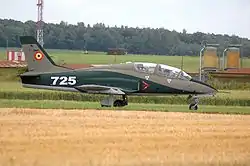Avioane Craiova
Avioane Craiova S.A. is an aeronautical company based in Ghercești, near Craiova, Romania. It has been involved in the manufacture of various military aircraft, including the IAR-93 Vultur ground-attack fighter, the IAR-99 advanced jet trainer/light attack aircraft, and the cancelled IAR-95 Spey fighter.
| Type | Public |
|---|---|
| Industry | Aeronautics |
| Founded | 1972 |
| Headquarters | , |
Area served | Worldwide |
| Services | Aerospace, Aircraft |
| Website | www.acv.ro |
Avioane was established in 1972 for the purpose of developing, manufacturing and providing support for several military aircraft. Its services have been principally used by the Romanian Air Force, although export sales have also been pursued by the company. Since the start of the 2000s, the Romanian government has made persistent efforts to privatise Avioane.
History

Immediately following its establishment in 1972, Avioane Craiova became involved in a multinational aircraft programme in which Romania co-operated with the neighbouring nation of Yugoslavia to jointly develop and produced a military twin-engined ground attack and tactical reconnaissance aircraft, the IAR-93 Vultur (Eagle).[1][2] In addition to Avioane, two other Romanian companies, Aerostar Bacău and IAR Brașov, along with the Yugoslavian aircraft manufacturer SOKO, worked together on the IAR-93 programme. First flown in 1985, around 200 aircraft were constructed and entered in service with the Romanian Air Force prior to the end of production in 1992. During the 1990s, Avioane independently proposed various upgrades and modifications to the IAR-93 fleet.[1]

Amid the late 1970s, Avioane commenced work on an envisioned indigenous supersonic fighter jet, commonly referred to as the IAR-95, which was intended to be adopted by the Romanian Air Force. However, work on the project was terminated in 1981, but revived shortly thereafter. During 1988, the IAR-95 programme was cancelled for a second and final time, allegedly due to a lack of available funds. Work had been halted prior to the completion of a single prototype, a full-scale mockup had reportedly been partially constructed.[3]
During the 1980s, another aircraft programme was launched by the company. This effort resulted in the development of an advanced jet trainer and light attack aircraft, the IAR-99.[1] Despite deliveries commencing in 1987, the programme was hampered by the decline in Romanian's economic conditions during the early 1990s. In September 1998, the Romanian government authorised the upgrade of the existing 24 IAR-99s of the Romanian Air Force with a new avionics suite that was developed in collaboration with the Israeli aerospace company Elbit Systems.[4] By 2009, Avioane was claiming that the IAR-99 remained in active production, specifically as the modernised IAR-99 Șoim (Hawk) variant.[5][6] By 2017, only 19 examples were in use with the Romanian Air Force, the type's sole operator to date. Avioane has continued to pursue upgrades and partnerships, as well as the promotion of IAR-99 in upgraded forms as late as September 2017.[7]
During the 2000s, the Romanian government has made efforts to privatise many of its state-owned assets, including Avioane. In May 2008, aerospace periodical Flight International reported that a total of three bidders had issued offers to acquire up to 81 percent of the company, these being the Italian aerospace manufacturer Alenia Aeronautica, the Czech Republic-based aircraft company Aero Vodochody, and local agency INAV Bucharest.[8] At one stage, Aero Vodochody appeared to by the frontrunner, the company having promoted its plans to develop Avioane's aerostructures capabilities. However, by October 2008, none of the bidders were willing to agree to the contractual terms presented and had therefore pulled out of the privatisation process, forcing it to be restarted.[9]
Products
Projects
- IAR-95 Spey
- IAR-109 Swift
See also
References
Citations
- "Military Aircaft Directory: Avioane". Flight International. 29 September 1998.
- Fredriksen 2001, p. 301.
- "Romanian Supersonic Project". incas.ro.
- "Romania approves funding for Soim upgrade". Flight International. 16 September 1998.
- "History". Archived from the original on 11 February 2011. Retrieved 28 September 2009.
- "Romania shows upgrades". Flight International. 18 June 1997.
- Hoyle, Craig (7 September 2017). "Vixen radar chosen for Romanian trainer project". Flight International.
- "Business briefings". Flight International. 28 May 2008.
- "Business briefings". Flight International. 6 October 2008.
Bibliography
- Fredriksen, John C. International Warbirds: An Illustrated Guide to World Military Aircraft, 1914-2000. ABC-CLIO, 2001. ISBN 1-57607-364-5.
